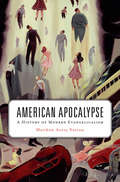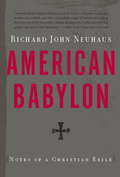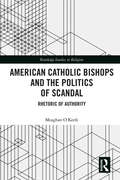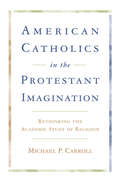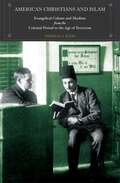- Table View
- List View
American and Muslim Worlds before 1900 (Islam of the Global West)
American and Muslim Worlds before 1900 challenges the prevailing assumption that when we talk about "American and Muslim worlds", we are talking about two conflicting entities that came into contact with each other in the 20th century. Instead, this book shows there is a long and deep seam of history between the two which provides an important context for contemporary events -- and is also important in its own right. Some of the earliest American Muslims were the African slaves working in the plantations of the Carolinas and Latin America. Thomas Jefferson, a slaveholder himself, was frequently called an "infidel" and suspected of hidden Muslim sympathies by his opponents. Whether it was the sale of American commodities in Central Asia, Ottoman consuls in Washington, orientalist themes in American fiction, the uprisings of enslaved Muslims in Brazil, or the travels of American missionaries in the Middle East, there was no shortage of opportunities for Muslims and inhabitants of the Americas to meet, interact and shape one another from an early period.
American Apocalypse: A History of Modern Evangelicalism
by Matthew Avery SuttonIn the first comprehensive history of American evangelicalism to appear in a generation, Matthew Sutton shows how charismatic Protestant preachers, anticipating the end of the world, paradoxically transformed it. Narrating the story from the perspective of the faithful, he shows how apocalyptic thinking influences the American mainstream today.
American Apocalypse: A History of Modern Evangelicalism
by Matthew Avery SuttonIn the first comprehensive history of American evangelicalism to appear in a generation, Matthew Sutton shows how charismatic Protestant preachers, anticipating the end of the world, paradoxically transformed it. Narrating the story from the perspective of the faithful, he shows how apocalyptic thinking influences the American mainstream today.
American Apocalyptic: Beliefs, Rituals, and Expressions of Doomsday Culture in the US
by Juli L. GittingerIn this book, Juli Gittinger argues that America’s fascination (obsession?) with the apocalypse is a synthesis of religion, popular culture, and politics in a way that is particular to the US and consonant with mythological-historical narratives of America. As a result, we can identify American apocalypticism as a sort of religion in itself that is closely tied to “civil religion,” that has a worldview and rituals that create identifiable communities and connects American mythology to apocalyptic anxieties. Gittinger discusses how various cultures and groups form as a result of this obsession, and that these communities form their own rituals and responses in various forms of “prepping” or survivalist practices. She lays out an argument for a broad eschatology prevalent in the US that extends beyond traditional religious designations to form an apocalyptic worldview that is built into our narrative as a country, as well as furthered by popular culture and media’s contributionto apocalyptic anxieties. Subsequently, Gittinger uses case studies of apocalyptic events—current or speculative—that reveal how our anxieties about the end of the world (as we know it) inform our culture, as well as religious narratives that emerge from such crises.
American Aurora: Environment and Apocalypse in the Life of Johannes Kelpius (Oxford Studies in Western Esotericism)
by Timothy Grieve-CarlsonAmerican Aurora explores the impact of climate change on early modern radical religious groups during the height of the Little Ice Age in the seventeenth century. Focusing on the life and legacy of Johannes Kelpius (1667-1707), an enormously influential but comprehensively misunderstood theologian who settled outside of Philadelphia from 1604 to 1707, Timothy Grieve-Carlson explores the Hermetic and alchemical dimensions of Kelpius's Christianity before turning to his legacy in American religion and literature. This engaging analysis showcases Kelpius's forgotten theological intricacies, spiritual revelations, and cosmic observations, illuminating the complexity and foresight of an important colonial mystic. As radical Protestants during Kelpius's lifetime struggled to understand their changing climate and a seemingly eschatological cosmos, esoteric texts became crucial sources of meaning. Grieve-Carlson presents original translations of Kelpius's university writings, which have never been published in English, along with analyses and translations of other important sources from the period in German and Latin. Ultimately, American Aurora points toward a time and place when climate change caused an eruption of esoteric thought and practice-and how this moment has been largely forgotten.
American Aurora: Environment and Apocalypse in the Life of Johannes Kelpius (Oxford Studies in Western Esotericism)
by Timothy Grieve-CarlsonAmerican Aurora explores the impact of climate change on early modern radical religious groups during the height of the Little Ice Age in the seventeenth century. Focusing on the life and legacy of Johannes Kelpius (1667-1707), an enormously influential but comprehensively misunderstood theologian who settled outside of Philadelphia from 1604 to 1707, Timothy Grieve-Carlson explores the Hermetic and alchemical dimensions of Kelpius's Christianity before turning to his legacy in American religion and literature. This engaging analysis showcases Kelpius's forgotten theological intricacies, spiritual revelations, and cosmic observations, illuminating the complexity and foresight of an important colonial mystic. As radical Protestants during Kelpius's lifetime struggled to understand their changing climate and a seemingly eschatological cosmos, esoteric texts became crucial sources of meaning. Grieve-Carlson presents original translations of Kelpius's university writings, which have never been published in English, along with analyses and translations of other important sources from the period in German and Latin. Ultimately, American Aurora points toward a time and place when climate change caused an eruption of esoteric thought and practice-and how this moment has been largely forgotten.
American Babylon: Notes of a Christian Exile
by Richard John NeuhausChristians are by their nature a people out of place. Their true home is with God; in civic life, they are alien citizens "in but not of the world.” In American Babylon, eminent theologian Richard John Neuhaus examines the particular truth of that ambiguity for Catholics in America today.Neuhaus addresses the essential quandaries of Catholic life-assessing how Catholics can keep their heads above water in the sea of immorality that confronts them in the world, how they can be patriotic even though their true country is not in this world, and how they might reconcile their duties as citizens with their commitment to God. Deeply learned, frequently combative, and always eloquent, American Babylon is Neuhaus's magnum opus-and will be essential reading for all Christians.
American Catholic: The Politics of Faith During the Cold War (Religion and American Public Life)
by D. G. HartAmerican Catholic places the rise of the United States' political conservatism in the context of ferment within the Roman Catholic Church. How did Roman Catholics shift from being perceived as un-American to emerging as the most vocal defenders of the United States as the standard bearer in world history for political liberty and economic prosperity? D. G. Hart charts the development of the complex relationship between Roman Catholicism and American conservatism, and shows how these two seemingly antagonistic ideological groups became intertwined in advancing a certain brand of domestic and international politics. Contrary to the standard narrative, Roman Catholics were some of the most assertive political conservatives directly after World War II, and their brand of politics became one of the most influential means by which Roman Catholicism came to terms with American secular society. It did so precisely as bishops determined the church needed to update its teaching about its place in the modern world. Catholics grappled with political conservatism long before the supposed rightward turn at the time of the Roe v. Wade decision in 1973.Hart follows the course of political conservatism from John F. Kennedy, the first and only Roman Catholic president of the United States, to George W. Bush, and describes the evolution of the church and its influence on American politics. By tracing the roots of Roman Catholic politicism in American culture, Hart argues that Roman Catholicism's adaptation to the modern world, whether in the United States or worldwide, was as remarkable as its achievement remains uncertain. In the case of Roman Catholicism, the effects of religion on American politics and political conservatism are indisputable.
American Catholic Bishops and the Politics of Scandal: Rhetoric of Authority (Routledge Studies in Religion)
by Meaghan O'KeefeThis book explores the rhetoric and public communication of the Catholic Church in the United States in the wake of the sexual abuse scandals and offers a demonstration of how large organizations negotiate a loss of public trust while retaining political power. While the Catholic Church remains a major political force in the United States, recent scandals have undoubtedly had an adverse effect on both its reputation and moral authority. This has been exacerbated by the public responses of Catholic clergy, which have often left supporters of the Church, let alone critics, profoundly unsatisfied. Drawing on documents – voting guides, pastoral letters, sermons, press releases, and other materials – issued by the United States Conference of Catholic Bishops (USCCB) as well as American nuns, the book explores Catholic political statements issued after the sexual abuse crises entered the public consciousness. Using approaches from linguistics and rhetoric, it analyses how these statements compare to similar materials issued before this time. This comparison demonstrates that for the American Catholic Church persuasion is less important than maintaining the impression that there has been no loss of authority. This is a timely study of the Catholic Church’s handling of the recent revelations of abuse within the Church. As such, it will be of keen interest to scholars of religious rhetoric, contemporary Catholicism, linguistics, rhetoric, communication, and religious studies.
American Catholic Bishops and the Politics of Scandal: Rhetoric of Authority (Routledge Studies in Religion)
by Meaghan O'KeefeThis book explores the rhetoric and public communication of the Catholic Church in the United States in the wake of the sexual abuse scandals and offers a demonstration of how large organizations negotiate a loss of public trust while retaining political power. While the Catholic Church remains a major political force in the United States, recent scandals have undoubtedly had an adverse effect on both its reputation and moral authority. This has been exacerbated by the public responses of Catholic clergy, which have often left supporters of the Church, let alone critics, profoundly unsatisfied. Drawing on documents – voting guides, pastoral letters, sermons, press releases, and other materials – issued by the United States Conference of Catholic Bishops (USCCB) as well as American nuns, the book explores Catholic political statements issued after the sexual abuse crises entered the public consciousness. Using approaches from linguistics and rhetoric, it analyses how these statements compare to similar materials issued before this time. This comparison demonstrates that for the American Catholic Church persuasion is less important than maintaining the impression that there has been no loss of authority. This is a timely study of the Catholic Church’s handling of the recent revelations of abuse within the Church. As such, it will be of keen interest to scholars of religious rhetoric, contemporary Catholicism, linguistics, rhetoric, communication, and religious studies.
The American Catholic Revolution: How the Sixties Changed the Church Forever
by Mark S. Massa, S.J.In the 1960s, the Second Vatican Council enacted the most sweeping changes the Catholic Church had seen in centuries. In readable and compelling prose, Mark S. Massa tells the story of the cultural war these changes ignited in the United States - a war that is still being waged today. Suddenly, one Sunday, the mass as the faithful had always known it was different, and so was the Church they had believed was timeless and unchanging. Once the Church opened the door to change, Massa argues, it could not be closed again. Skirmishes broke out over the proper way to worship. Soon, Catholics were bitterly divided over birth control, abortion, celibacy, female priests, and the authority of the Church itself. As he narrates these turbulent events, Massa takes us beyond stereotypes of liberals and conservatives, offering new insights into the last fifty years of American Catholicism.
The American Catholic Revolution: How the Sixties Changed the Church Forever
by Mark S. Massa, S.J.In the 1960s, the Second Vatican Council enacted the most sweeping changes the Catholic Church had seen in centuries. In readable and compelling prose, Mark S. Massa tells the story of the cultural war these changes ignited in the United States - a war that is still being waged today. Suddenly, one Sunday, the mass as the faithful had always known it was different, and so was the Church they had believed was timeless and unchanging. Once the Church opened the door to change, Massa argues, it could not be closed again. Skirmishes broke out over the proper way to worship. Soon, Catholics were bitterly divided over birth control, abortion, celibacy, female priests, and the authority of the Church itself. As he narrates these turbulent events, Massa takes us beyond stereotypes of liberals and conservatives, offering new insights into the last fifty years of American Catholicism.
American Catholic Women Religious: Radicalized by Mission
by Donna Maria MosesThis book depicts the significant role played by American Catholic Women Religious in the broader narratives of modern American history and the history of the Catholic Church. The book is a guide to fifty foreign missions founded by Dominican and Maryknoll Sisters in the twentieth century. Sister Donna Moses examines root causes for the radical political stances taken by American Catholic Women Religious in the latter half of the century and for the conservative backlash that followed. The book identifies key events that contributed to the present state of division within the American Catholic Church and describes current efforts to engage in dynamic dialogue.
American Catholic Women Religious: Radicalized by Mission
by Donna Maria MosesThis book depicts the significant role played by American Catholic Women Religious in the broader narratives of modern American history and the history of the Catholic Church. The book is a guide to fifty foreign missions founded by Dominican and Maryknoll Sisters in the twentieth century. Sister Donna Moses examines root causes for the radical political stances taken by American Catholic Women Religious in the latter half of the century and for the conservative backlash that followed. The book identifies key events that contributed to the present state of division within the American Catholic Church and describes current efforts to engage in dynamic dialogue.
American Catholicism: And Now Where?
by John G. DeedyTHE AMERICAN CATHOLIC church is a remarkable institu tion. Its people worship in numbers that dwarf figures from elsewhere. It has one of the most vibrant of Cath olic school systems, perhaps the most vibrant. It is by and large an obedient church, some would say docile controversies of recent years notwithstanding. It is a church characterized by great loyalty to the pope and by unstinting financial generosity to Rome. Still, the Ameri can church is a church in transition. There has been ero sion in areas of church life. Yet more is likely. The vii viii PREFACE American Catholic church, in sum, is a ready-made sub ject for analysis and study. When this book project on American Catholicism was first broached, no particular time urgency seemed to be involved. In recent years, nuns and priests had ex ited the religious life by the thousands, and their ranks were not being refilled. Many seminaries and convents had been closed for lack of need, then sold off to meet the financial imperatives of the respective religious com munities. The administration of Catholic hospitals in several cities had been turned over to lay boards, and a few Catholic colleges had shut their gates. A number of Catholic publications had disappeared from view, and in many Catholic parishes, focuses shifted, often to ac tivities of apostolic inconsequence, as emphases drained away from diocesan schools, very many of which had closed for good.
American Catholicism Transformed: From the Cold War Through the Council
by Joseph P. ChinniciSituating the church within the context of post-World War II globalization and the Cold War, American Catholicism Transformed draws on previously untapped archival sources to provide deep background to developments within the American Catholic Church in relationship to American society at large. Shaped by anti-communist sentiment and responsive to American cultural trends, the Catholic community adopted "strategies of domestic containment," stressing the close unity between the Church and the "American way of life." A focus on the unchanging character of God's law as expressed in social hierarchies of authority, race, and gender provided a public visage of unity and uniformity. However, the emphasis on American values mainstreamed into the community the political values of personal rights, equality, acceptance of the arms race, and muted the Church's inherited social vision. The result was a deep ambivalence over the forces of secularization. The Catholic community entered a transitional stage in which "those on the right" and "those on the left" battled for control of the Church's vision. International networking, reform of religious life among women, international congresses of the laity, the institutionalization of the liturgical movement, and the burgeoning civil right movement positioned the community to receive the Vatican Council in a distinctly American way. During the Second Vatican Council, the American bishops and theological experts gradually adopted the reforming currents of the world-wide Church. This convergence of international and national forces of renewal -- and resistance to them -- says Joseph Chinnici, will continue to shape the American Catholic community's identity in the twenty-first century.
American Catholicism Transformed: From the Cold War Through the Council
by Joseph P. ChinniciSituating the church within the context of post-World War II globalization and the Cold War, American Catholicism Transformed draws on previously untapped archival sources to provide deep background to developments within the American Catholic Church in relationship to American society at large. Shaped by anti-communist sentiment and responsive to American cultural trends, the Catholic community adopted "strategies of domestic containment," stressing the close unity between the Church and the "American way of life." A focus on the unchanging character of God's law as expressed in social hierarchies of authority, race, and gender provided a public visage of unity and uniformity. However, the emphasis on American values mainstreamed into the community the political values of personal rights, equality, acceptance of the arms race, and muted the Church's inherited social vision. The result was a deep ambivalence over the forces of secularization. The Catholic community entered a transitional stage in which "those on the right" and "those on the left" battled for control of the Church's vision. International networking, reform of religious life among women, international congresses of the laity, the institutionalization of the liturgical movement, and the burgeoning civil right movement positioned the community to receive the Vatican Council in a distinctly American way. During the Second Vatican Council, the American bishops and theological experts gradually adopted the reforming currents of the world-wide Church. This convergence of international and national forces of renewal -- and resistance to them -- says Joseph Chinnici, will continue to shape the American Catholic community's identity in the twenty-first century.
American Catholics: A History (Cushwa Center Studies Of Catholicism In Twentieth-century America)
by Leslie Woodcock TentlerA sweeping history of American Catholicism from the arrival of the first Spanish missionaries to the present This comprehensive survey of Catholic history in what became the United States spans nearly five hundred years, from the arrival of the first Spanish missionaries to the present. Distinguished historian Leslie Tentler explores lay religious practice and the impact of clergy on Catholic life and culture as she seeks to answer the question, What did it mean to be a "good Catholic" at particular times and in particular places? In its focus on Catholics' participation in American politics and Catholic intellectual life, this book includes in-depth discussions of Catholics, race, and the Civil War; Catholics and public life in the twentieth century; and Catholic education and intellectual life. Shedding light on topics of recent interest such as the role of Catholic women in parish and community life, Catholic reproductive ethics regarding birth control, and the Catholic church sex abuse crisis, this engaging history provides an up-to-date account of the history of American Catholicism.
American Catholics and the Church of Tomorrow: Building Churches for the Future, 1925–1975
by Catherine R. OsborneIn the mid-twentieth century, American Catholic churches began to shed the ubiquitous spires, stained glass, and gargoyles of their European forebears, turning instead toward startling and more angular structures of steel, plate glass, and concrete. But how did an institution like the Catholic Church, so often seen as steeped in inflexible traditions, come to welcome this modernist trend? Catherine R. Osborne’s innovative new book finds the answer: the alignment between postwar advancements in technology and design and evolutionary thought within the burgeoning American Catholic community. A new, visibly contemporary approach to design, church leaders thought, could lead to the rebirth of the church community of the future. As Osborne explains, the engineering breakthroughs that made modernist churches feasible themselves raised questions that were, for many Catholics, fundamentally theological. Couldn’t technological improvements engender worship spaces that better reflected God's presence in the contemporary world? Detailing the social, architectural, and theological movements that made modern churches possible, American Catholics and the Churches of Tomorrow breaks important new ground in the history of American Catholicism, and also presents new lines of thought for scholars attracted to modern architectural and urban history.
American Catholics and the Church of Tomorrow: Building Churches for the Future, 1925–1975
by Catherine R. OsborneIn the mid-twentieth century, American Catholic churches began to shed the ubiquitous spires, stained glass, and gargoyles of their European forebears, turning instead toward startling and more angular structures of steel, plate glass, and concrete. But how did an institution like the Catholic Church, so often seen as steeped in inflexible traditions, come to welcome this modernist trend? Catherine R. Osborne’s innovative new book finds the answer: the alignment between postwar advancements in technology and design and evolutionary thought within the burgeoning American Catholic community. A new, visibly contemporary approach to design, church leaders thought, could lead to the rebirth of the church community of the future. As Osborne explains, the engineering breakthroughs that made modernist churches feasible themselves raised questions that were, for many Catholics, fundamentally theological. Couldn’t technological improvements engender worship spaces that better reflected God's presence in the contemporary world? Detailing the social, architectural, and theological movements that made modern churches possible, American Catholics and the Churches of Tomorrow breaks important new ground in the history of American Catholicism, and also presents new lines of thought for scholars attracted to modern architectural and urban history.
American Catholics and the Church of Tomorrow: Building Churches for the Future, 1925–1975
by Catherine R. OsborneIn the mid-twentieth century, American Catholic churches began to shed the ubiquitous spires, stained glass, and gargoyles of their European forebears, turning instead toward startling and more angular structures of steel, plate glass, and concrete. But how did an institution like the Catholic Church, so often seen as steeped in inflexible traditions, come to welcome this modernist trend? Catherine R. Osborne’s innovative new book finds the answer: the alignment between postwar advancements in technology and design and evolutionary thought within the burgeoning American Catholic community. A new, visibly contemporary approach to design, church leaders thought, could lead to the rebirth of the church community of the future. As Osborne explains, the engineering breakthroughs that made modernist churches feasible themselves raised questions that were, for many Catholics, fundamentally theological. Couldn’t technological improvements engender worship spaces that better reflected God's presence in the contemporary world? Detailing the social, architectural, and theological movements that made modern churches possible, American Catholics and the Churches of Tomorrow breaks important new ground in the history of American Catholicism, and also presents new lines of thought for scholars attracted to modern architectural and urban history.
American Catholics and the Church of Tomorrow: Building Churches for the Future, 1925–1975
by Catherine R. OsborneIn the mid-twentieth century, American Catholic churches began to shed the ubiquitous spires, stained glass, and gargoyles of their European forebears, turning instead toward startling and more angular structures of steel, plate glass, and concrete. But how did an institution like the Catholic Church, so often seen as steeped in inflexible traditions, come to welcome this modernist trend? Catherine R. Osborne’s innovative new book finds the answer: the alignment between postwar advancements in technology and design and evolutionary thought within the burgeoning American Catholic community. A new, visibly contemporary approach to design, church leaders thought, could lead to the rebirth of the church community of the future. As Osborne explains, the engineering breakthroughs that made modernist churches feasible themselves raised questions that were, for many Catholics, fundamentally theological. Couldn’t technological improvements engender worship spaces that better reflected God's presence in the contemporary world? Detailing the social, architectural, and theological movements that made modern churches possible, American Catholics and the Churches of Tomorrow breaks important new ground in the history of American Catholicism, and also presents new lines of thought for scholars attracted to modern architectural and urban history.
American Catholics in the Protestant Imagination: Rethinking the Academic Study of Religion
by Michael P. CarrollMichael P. Carroll argues that the academic study of religion in the United States continues to be shaped by a "Protestant imagination" that has warped our perception of the American religious experience and its written history and analysis.In this provocative study, Carroll explores a number of historiographical puzzles that emerge from the American Catholic story as it has been understood through the Protestant tradition. Reexamining the experience of Catholicism among Irish immigrants, Italian Americans, Acadians and Cajuns, and Hispanics, Carroll debunks the myths that have informed much of this history.Shedding new light on lived religion in America, Carroll moves an entire academic field in new, exciting directions and challenges his fellow scholars to open their minds and eyes to develop fresh interpretations of American religious history.
American Christians and Islam: Evangelical Culture and Muslims from the Colonial Period to the Age of Terrorism (PDF)
by Thomas S. KiddIn the wake of the September 11 terrorist attacks, many of America's Christian evangelicals have denounced Islam as a "demonic" and inherently violent religion, provoking frustration among other Christian conservatives who wish to present a more appealing message to the world's Muslims. Yet as Thomas Kidd reveals in this sobering book, the conflicted views expressed by today's evangelicals have deep roots in American history. Tracing Islam's role in the popular imagination of American Christians from the colonial period to today, Kidd demonstrates that Protestant evangelicals have viewed Islam as a global threat--while also actively seeking to convert Muslims to the Christian faith--since the nation's founding. He shows how accounts of "Mahometan" despotism and lurid stories of European enslavement by Barbary pirates fueled early evangelicals' fears concerning Islam, and describes the growing conservatism of American missions to Muslim lands up through the post-World War II era. Kidd exposes American Christians' anxieties about an internal Islamic threat from groups like the Nation of Islam in the 1960s and America's immigrant Muslim population today, and he demonstrates why Islam has become central to evangelical "end-times" narratives. Pointing to many evangelicals' unwillingness to acknowledge Islam's theological commonalities with Christianity and their continued portrayal of Islam as an "evil" and false religion, Kidd explains why Christians themselves are ironically to blame for the failure of evangelism in the Muslim world. American Christians and Islam is essential reading for anyone seeking to understand the causes of the mounting tensions between Christians and Muslims today.
American Christians and Islam: Evangelical Culture and Muslims from the Colonial Period to the Age of Terrorism (pdf)
by Thomas S. KiddIn the wake of the September 11 terrorist attacks, many of America's Christian evangelicals have denounced Islam as a "demonic" and inherently violent religion, provoking frustration among other Christian conservatives who wish to present a more appealing message to the world's Muslims. Yet as Thomas Kidd reveals in this sobering book, the conflicted views expressed by today's evangelicals have deep roots in American history. Tracing Islam's role in the popular imagination of American Christians from the colonial period to today, Kidd demonstrates that Protestant evangelicals have viewed Islam as a global threat--while also actively seeking to convert Muslims to the Christian faith--since the nation's founding. He shows how accounts of "Mahometan" despotism and lurid stories of European enslavement by Barbary pirates fueled early evangelicals' fears concerning Islam, and describes the growing conservatism of American missions to Muslim lands up through the post-World War II era. Kidd exposes American Christians' anxieties about an internal Islamic threat from groups like the Nation of Islam in the 1960s and America's immigrant Muslim population today, and he demonstrates why Islam has become central to evangelical "end-times" narratives. Pointing to many evangelicals' unwillingness to acknowledge Islam's theological commonalities with Christianity and their continued portrayal of Islam as an "evil" and false religion, Kidd explains why Christians themselves are ironically to blame for the failure of evangelism in the Muslim world. American Christians and Islam is essential reading for anyone seeking to understand the causes of the mounting tensions between Christians and Muslims today.

